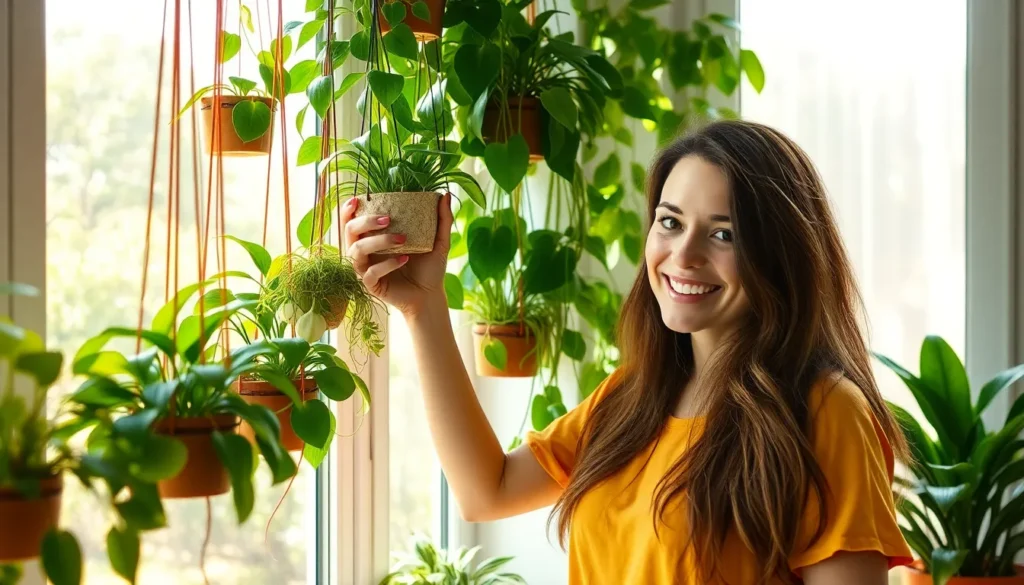We’ve all admired those Instagram-worthy windows draped with cascading greenery that transforms any space into a natural sanctuary. Hanging plants in windows aren’t just a trending décor element – they’re a game-changing solution for maximizing your plant collection while creating stunning visual impact.
Window-hung plants offer the perfect marriage of form and function. They use vertical space efficiently while providing your green friends with optimal light exposure. Whether you’re working with a tiny apartment or spacious home, this versatile approach lets you cultivate lush indoor gardens without sacrificing precious floor space.
From trailing pothos that create living curtains to flowering varieties that add pops of color, we’ll show you how to select the right plants, choose appropriate hanging systems, and master placement techniques. You’ll discover how strategic window gardening can enhance your home’s aesthetic while boosting your mood and air quality naturally.
Choose the Right Hanging Plants for Window Displays
Selecting the perfect hanging plants for your window displays requires careful consideration of your space’s unique conditions. We’ll help you match plants to your exact window environment for thriving displays.
Light Requirements for Different Plant Types
Full Sun Plants thrive in south-facing windows with 6-8 hours of direct sunlight. Petunias, geraniums, and trailing tomatoes excel in these bright conditions. We recommend positioning these plants within 3 feet of the window glass for optimal growth.
Partial Sun Plants perform best in east or west-facing windows receiving 4-6 hours of sunlight. Spider plants, tradescantia, and string of hearts adapt well to these moderate light conditions. These versatile options work perfectly in most window locations throughout your home.
Shade-Tolerant Plants flourish in north-facing windows or areas with filtered light. Pothos, philodendrons, and Boston ferns require only 2-4 hours of indirect sunlight daily. We’ve found these plants particularly forgiving for beginners starting their window garden journey.
Size Considerations for Window Spaces
Compact Windows measuring 24 inches or less benefit from small plants in 4-6 inch containers. Air plants, string of pearls, and small pothos varieties won’t overwhelm narrow window frames. We suggest limiting these spaces to 1-2 hanging plants to avoid crowding.
Medium Windows spanning 24-48 inches accommodate plants in 6-8 inch containers comfortably. Trailing begonias, ivy varieties, and medium-sized ferns create beautiful displays without blocking natural light. These windows typically support 2-3 hanging plants arranged at varying heights.
Large Windows exceeding 48 inches can showcase dramatic displays with 8-12 inch containers. Boston ferns, large spider plants, and cascading petunias create stunning focal points in spacious areas. We recommend grouping 3-5 plants at different levels for maximum visual impact.
Best Plants for Low-Light Windows
Pothos varieties including golden, marble queen, and neon types tolerate low light exceptionally well. These trailing beauties grow 4-10 feet long and require water only when soil feels dry. We’ve seen pothos thrive in bathrooms and north-facing kitchen windows with minimal care.
ZZ plants (Zamioculcas zamiifolia) feature glossy leaves and survive in almost any lighting condition. Their upright growth habit works well in hanging planters, reaching 2-3 feet tall. These plants need water only every 2-3 weeks, making them perfect for busy lifestyles.
Peace lilies produce elegant white blooms even in low-light conditions while filtering indoor air. Their arching leaves create graceful displays in hanging containers, growing 1-4 feet depending on variety. We recommend misting these plants weekly to maintain their tropical appearance.
Philodendrons including heartleaf and Brasil varieties cascade beautifully from hanging planters in dim corners. These fast-growing plants extend 4-6 feet and root easily in water for propagation. Their heart-shaped leaves add natural charm to any window display year-round.
Select Appropriate Hanging Planters and Containers
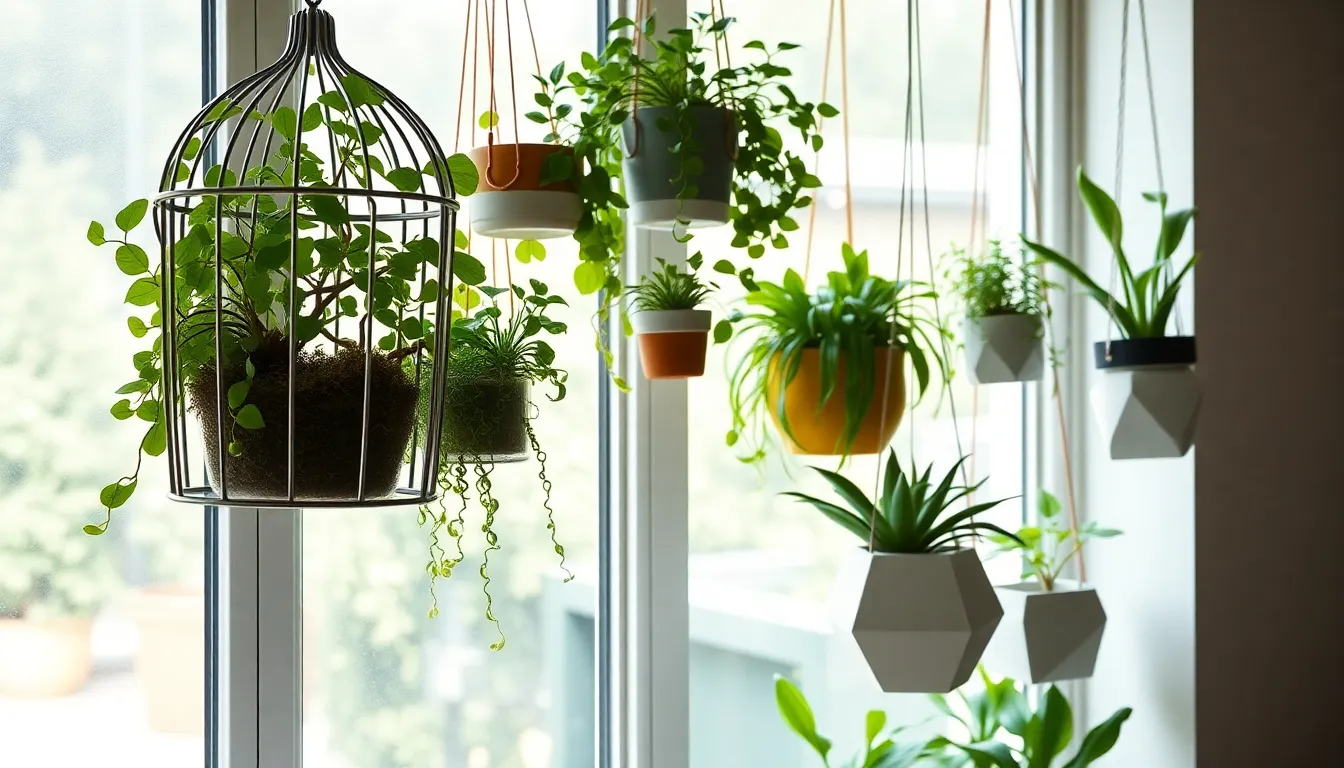
Choosing the right containers makes all the difference in creating successful window displays that thrive for years. We’ll explore the essential considerations that ensure your hanging plants stay healthy and secure.
Drainage Requirements for Window Plants
Proper drainage prevents root rot and maintains healthy plant growth. Select planters with drainage holes or add a layer of gravel at the bottom to help excess water flow. Window hanging plants face unique watering challenges since excess water needs somewhere to go without damaging your floors or windowsills.
Removable containers simplify maintenance and protect your home. Use planters that can be easily lifted out for thorough watering and drainage. Adjustable rods or brackets allow you to remove containers completely, making it easier to water plants in a sink or bathtub where drainage isn’t a concern.
Saucers and drip trays catch excess water effectively. Place waterproof saucers beneath hanging planters to collect drainage water. Clear acrylic or decorative ceramic saucers work well and can be emptied regularly to prevent overflow issues.
Weight Capacity for Window Mounting
Evaluate the total weight before selecting mounting hardware. Calculate the combined weight of your plant, wet soil, and container to determine the proper support needed. Wet soil significantly increases the overall weight, sometimes doubling the load compared to dry conditions.
Window frame brackets require careful installation and weight ratings. Use mounting hardware specifically rated for the expected load when installing brackets on window frames. Curtain rod style brackets work well for lighter plants, while heavy duty brackets designed for shelving can support larger specimens.
Ceiling mounting near windows offers superior weight capacity. Install ceiling hooks into joists or use toggle bolts for drywall applications when your plants exceed window frame weight limits. Test the strength of all mounting hardware before hanging plants to ensure safety and prevent accidents.
Aesthetic Styles to Match Your Decor
Minimalist displays create clean, modern window focal points. Single statement plants in sleek containers complement contemporary and scandinavian decor styles. Choose simple geometric planters in neutral colors like white, black, or natural wood tones for this approach.
Clustered arrangements add visual interest and plant variety. Group small planters at different heights to create ever-changing window displays that work well with eclectic or bohemian interior styles. Mix container materials like woven baskets, ceramic pots, and metal planters for textural contrast.
Repurposed containers bring unique character to your windows. Transform vintage birdcages, old colanders, or woven baskets into distinctive hanging planters that serve as conversation pieces. Add rope or macrame hangers to repurposed items for rustic or farmhouse aesthetics that complement traditional home decor.
Install Proper Hanging Hardware for Window Plants
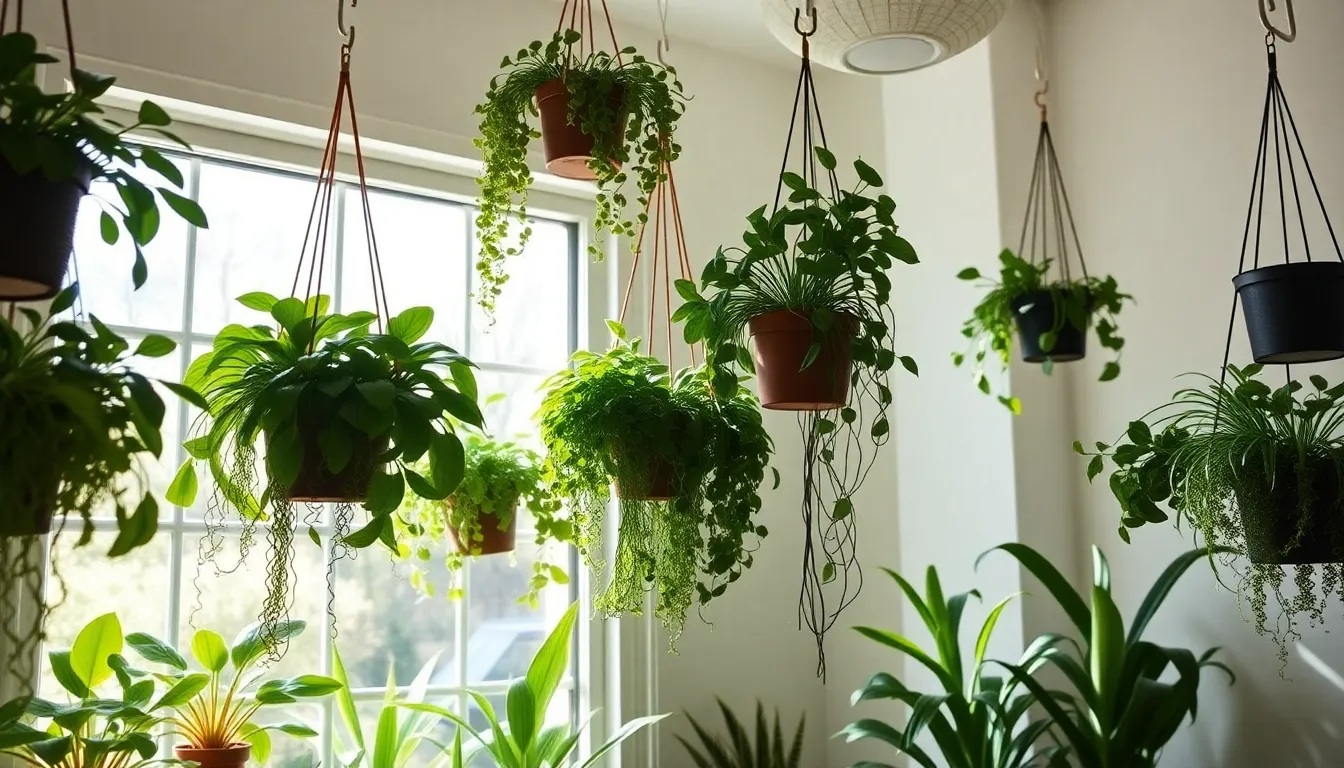
Now that we’ve selected our containers and assessed weight requirements, let’s focus on the hardware that’ll securely support our window plants. Proper installation prevents accidents and ensures our plants thrive in their new vertical garden space.
Ceiling Mount Options for Heavy Plants
Screw-in ceiling hooks provide the strongest support for plants weighing up to 50 pounds or more when anchored directly into ceiling joists. We recommend using a stud finder to locate these structural supports before drilling, as this prevents potential falls and property damage.
Toggle bolts with swag hooks work well for medium-weight plants when ceiling joists can’t be located in drywall installations. These expanding anchors distribute weight across a larger surface area, though we suggest testing the weight capacity with your exact plant and container combination before permanent installation.
Stud finder technology has become essential for safe ceiling mounting, helping us identify solid wood joists that can handle substantial weight loads. Professional installers consistently recommend this step to avoid the common mistake of drilling into hollow spaces that can’t support hanging plants.
Window Frame Mounting Techniques
Tension rods install inside window frames without any tools or permanent modifications, making them perfect for rental properties or temporary displays. These adjustable rods work best for small plants under 5 pounds, as their grip strength has natural limitations.
Mounting brackets paired with dowels create adjustable hanging systems that accommodate multiple plants at varying heights. We install these brackets directly on window sashes or adjacent frame areas, then slide dowels through to create customizable hanging points for our plant collection.
DIY adjustable systems using this bracket and dowel approach allow us to rearrange plants seasonally or as they grow, providing flexibility that fixed mounting points can’t offer. This method works particularly well for creating layered displays with plants of different sizes.
Wall-Mounted Brackets for Side Windows
Sturdy wall brackets attached next to windows provide excellent support for plants requiring indirect light or those we want to position at exact heights. These permanent installations handle heavier loads than window frame options while maintaining easy access for plant care.
Appropriate anchors and screws must match our wall type, whether we’re dealing with drywall, plaster, or masonry surfaces. We choose hardware rated for at least twice the weight of our heaviest plant to ensure a safety margin.
Layered plant displays become possible with multiple wall brackets installed at different heights, creating an attractive cascading effect that draws the eye upward. This technique works especially well for mixing trailing plants with upright varieties in the same window area.
Position Your Hanging Plants for Optimal Growth
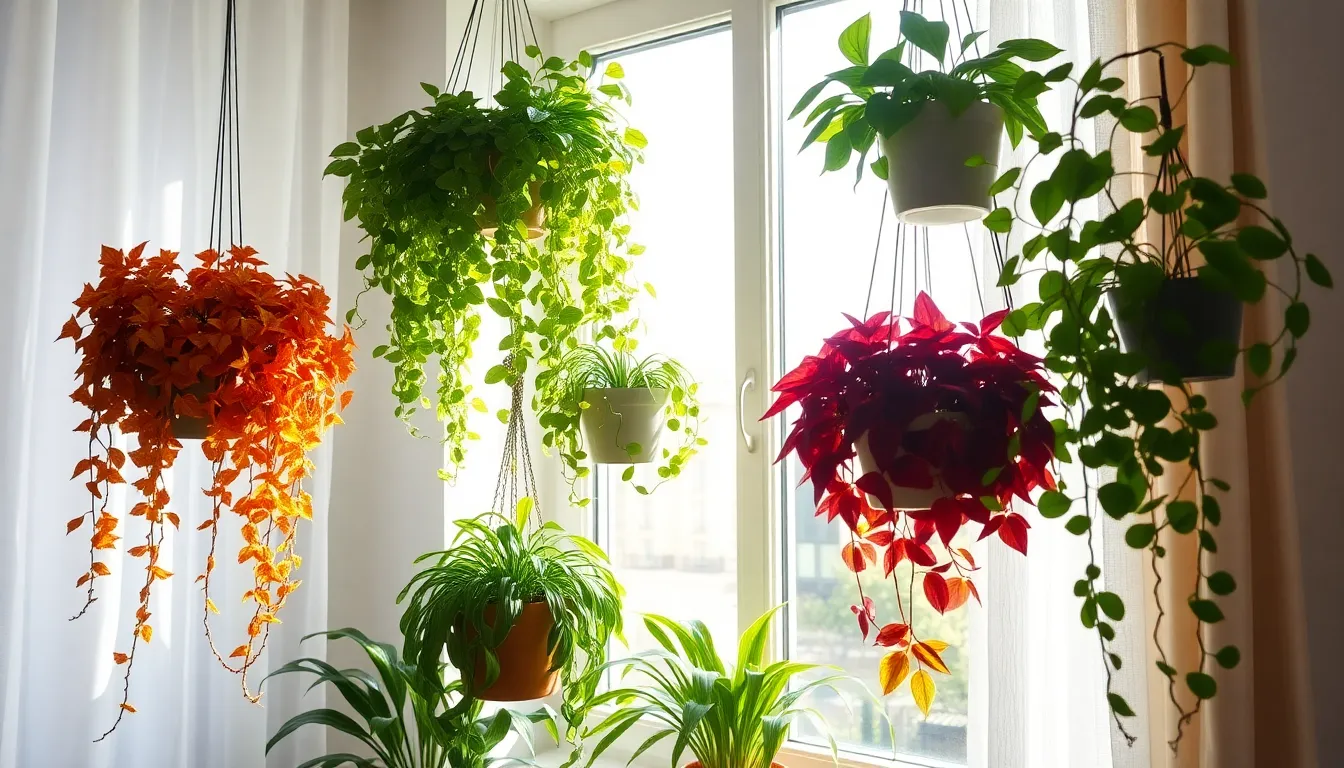
Now that we’ve covered installation basics, let’s focus on strategic placement to maximize your plants’ health and beauty.
Distance from Window Glass
South and west facing windows require the most careful positioning due to their intense sunlight exposure. We recommend placing high light plants a short distance away from the glass rather than directly against it to prevent leaf burn. Alternatively, we can use diffusing curtains to filter harsh rays while maintaining adequate brightness.
Bright indirect light plants thrive when positioned near but not directly at south, west, or east facing windows. This positioning gives them the luminosity they crave without the scorching intensity of direct contact with glass.
Medium light plants offer more flexibility in placement, performing well several feet away from south facing windows or positioned right at north facing windows where natural light levels remain gentler throughout the day.
Height Adjustments for Light Exposure
Trailing plants benefit from higher hanging positions that allow their stems to cascade freely while maximizing light exposure near the window’s upper portion. We’ve found this approach creates the most dramatic visual impact while supporting healthy growth patterns.
Ceiling height limitations shouldn’t discourage you from hanging plants higher. We can simply prune long stems to maintain manageable sizes without compromising the plant’s light requirements or overall health.
Layered arrangements work exceptionally well when we group hanging plants at varying heights. This technique optimizes available light distribution while creating an attractive stepped effect that draws the eye naturally upward through the display.
Spacing Between Multiple Plants
Adequate spacing prevents shadowing between plants, which reduces photosynthesis efficiency and increases disease risks. We ensure each plant receives sufficient light and air circulation by avoiding overcrowded arrangements.
Competition prevention occurs when we leave enough room between hanging plants, allowing trailing vines and leaves to grow without tangling or blocking each other’s access to precious window light.
Natural privacy screens emerge when we space multiple hanging plants properly in front of windows. This arrangement creates an attractive living barrier while maintaining the aesthetic appeal and health of each individual plant in our display.
Water and Maintain Your Window Hanging Plants
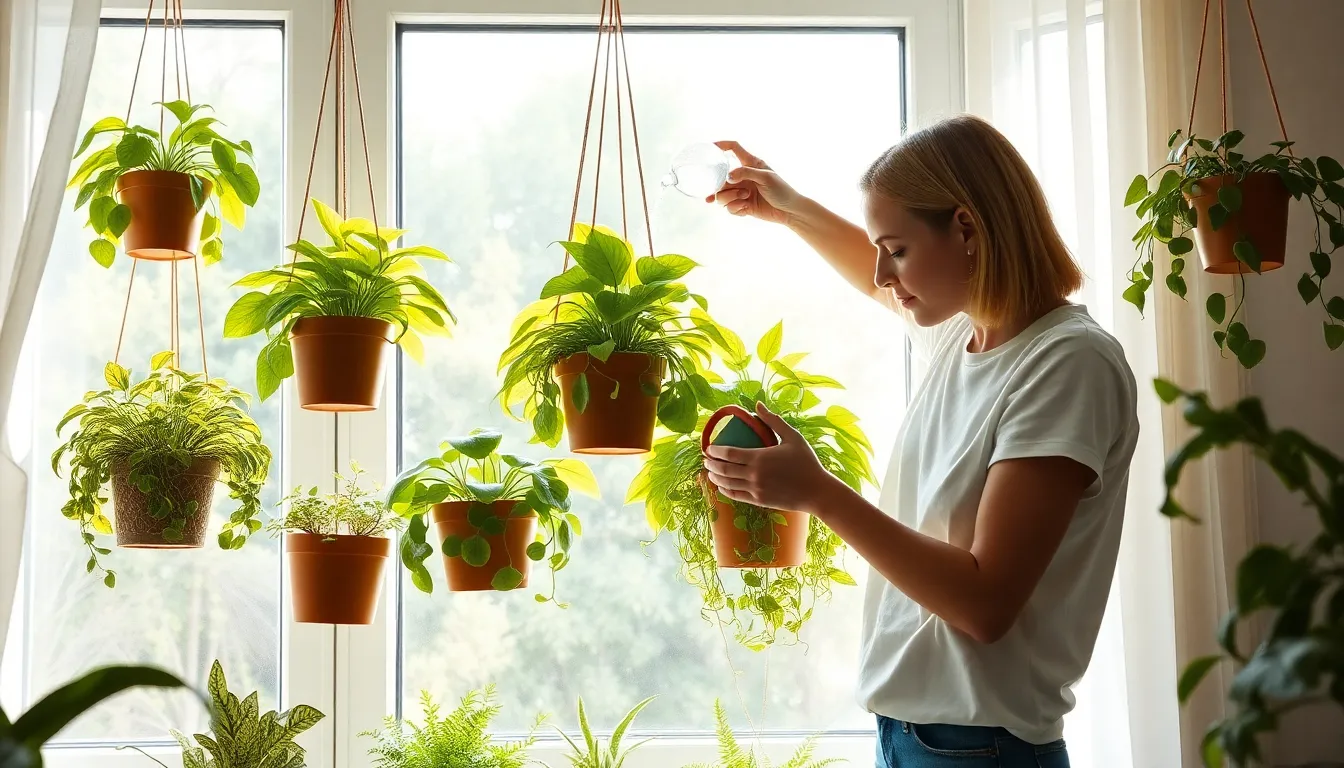
Once your hanging plants are perfectly positioned in your windows, consistent care becomes crucial for their long-term success. Window locations present unique watering and maintenance challenges that require exact strategies to keep plants thriving.
Watering Schedules for Different Plant Types
Check soil moisture by inserting your finger about an inch (2.5 cm) into the soil before watering any hanging plant. Most hanging plants benefit from watering when the top inch of soil feels dry, which helps prevent both overwatering and underwatering issues.
Adjust frequency based on seasonal changes and daily conditions. Hot, sunny days may require watering once or twice daily, while cooler months might reduce frequency to every few days as plants absorb less water.
Test container weight to gauge soil moisture levels accurately. Light containers indicate dryness and signal the need for immediate watering, while heavy pots suggest adequate moisture remains.
Water thoroughly until excess water drains from the bottom drainage holes. This technique ensures roots receive proper hydration throughout the soil, but avoid letting plants sit in standing water to prevent root rot.
Install self-watering systems for consistent moisture delivery. Self-watering inserts or DIY systems using water bottles with small holes provide steady moisture, reducing your daily watering frequency significantly.
Preventing Water Damage to Window Areas
Ensure proper drainage in all hanging planters by confirming drainage holes or plugs allow excess water to escape. Adequate drainage prevents water pooling that can damage window sills and surrounding wooden frames.
Place catch trays or waterproof mats beneath indoor hanging pots to collect runoff water. These protective barriers safeguard surfaces from water stains and potential rot damage.
Direct water away from window frames and sills during watering sessions. Controlled watering tools like watering wands or cans with precision spouts help you avoid contact with sensitive window areas.
Pruning Techniques for Healthy Growth
Remove faded blooms regularly by pinching off dead flowers at the leaf node. This deadheading technique encourages new blooms instead of seed production, which conserves the plant’s energy for continued flowering.
Trim dead or yellow leaves immediately to improve plant appearance and prevent disease spread. Cut away any damaged or discolored foliage using clean pruning shears to maintain plant health.
Shape plant growth through light trimming to maintain balanced proportions. Strategic pruning prevents overcrowding and improves airflow around leaves, reducing the risk of fungal issues in humid window environments.
Troubleshoot Common Issues with Window Hanging Plants
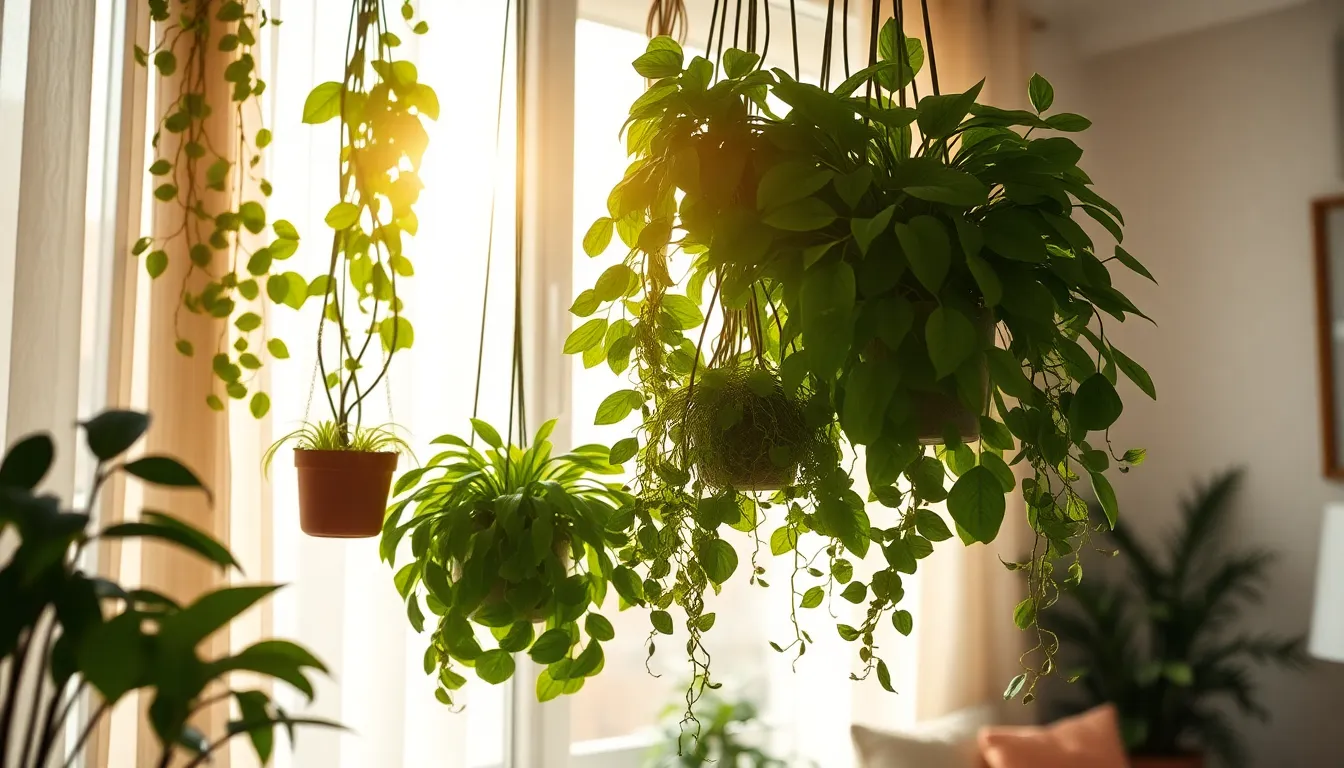
Even with proper setup and care, window hanging plants can face exact challenges that require quick answers. We’ll help you identify and resolve the most common problems to keep your plants thriving.
Dealing with Excessive Heat from Windows
Window heat can stress hanging plants and cause leaf burn, especially in south-facing windows where intense direct sunlight builds up. Plants placed too close to glass experience the highest temperatures and may show signs like brown or scorched leaf edges.
Distance becomes crucial when protecting plants from excessive heat. We recommend keeping hanging plants at least 12-18 inches away from window glass where heat buildup peaks. Light, sheer curtains effectively diffuse harsh sunlight while still allowing beneficial light to reach your plants.
Plant selection makes a important difference for hot window locations. Heat-tolerant varieties like Pothos and Hoya handle bright, warm conditions better than delicate species. Regular rotation prevents uneven exposure and promotes balanced growth.
| Heat Stress Signs | Answers |
|---|---|
| Brown leaf edges | Move plants away from glass |
| Wilting even though moist soil | Add sheer curtains |
| Rapid soil drying | Choose heat-tolerant varieties |
| Uneven growth patterns | Rotate plants weekly |
Managing Humidity Levels
Low humidity affects hanging plants more severely than ground-level plants because warm air rises and creates drier conditions near windows. Indoor heating systems during winter months compound this problem by removing moisture from the air.
Brown leaf tips and faster soil drying indicate insufficient humidity levels around your hanging plants. We’ve found that hanging plants dry out approximately 25% faster than plants at floor level due to increased air circulation and heat exposure.
Humidity answers work best when implemented consistently. Misting plants regularly helps, but using a humidifier near your window display provides more stable moisture levels. Grouping humidity-loving plants together creates a beneficial microclimate that all plants share.
Watering frequency needs adjustment for hanging plants since they experience faster moisture loss. We recommend checking soil daily and watering more frequently than surface plants to compensate for increased evaporation rates.
Addressing Pest Problems in Indoor Plants
Pest infestations spread quickly among hanging plants because insects easily move between closely spaced containers. Spider mites, aphids, and scale insects commonly target stressed plants with poor air circulation or excessive moisture buildup.
Regular inspection becomes essential for early pest detection. We suggest checking the undersides of leaves weekly since many pests prefer these hidden areas. Catching infestations early prevents them from spreading throughout your entire window display.
Isolation protects healthy plants when you discover pest problems. Remove affected plants immediately and treat them away from your main display area. Insecticidal soap and neem oil treatments effectively control most common indoor plant pests without harsh chemicals.
Prevention strategies reduce pest risks significantly. Proper airflow around hanging plants discourages pest establishment, while avoiding excessive moisture buildup eliminates breeding conditions. We maintain adequate spacing between plants to promote good air circulation and reduce pest pressure.
| Common Pests | Treatment Methods |
|---|---|
| Spider mites | Neem oil spray |
| Aphids | Insecticidal soap |
| Scale insects | Alcohol wipe treatment |
| Thrips | Yellow sticky traps |
Style Your Window Space with Hanging Plant Arrangements
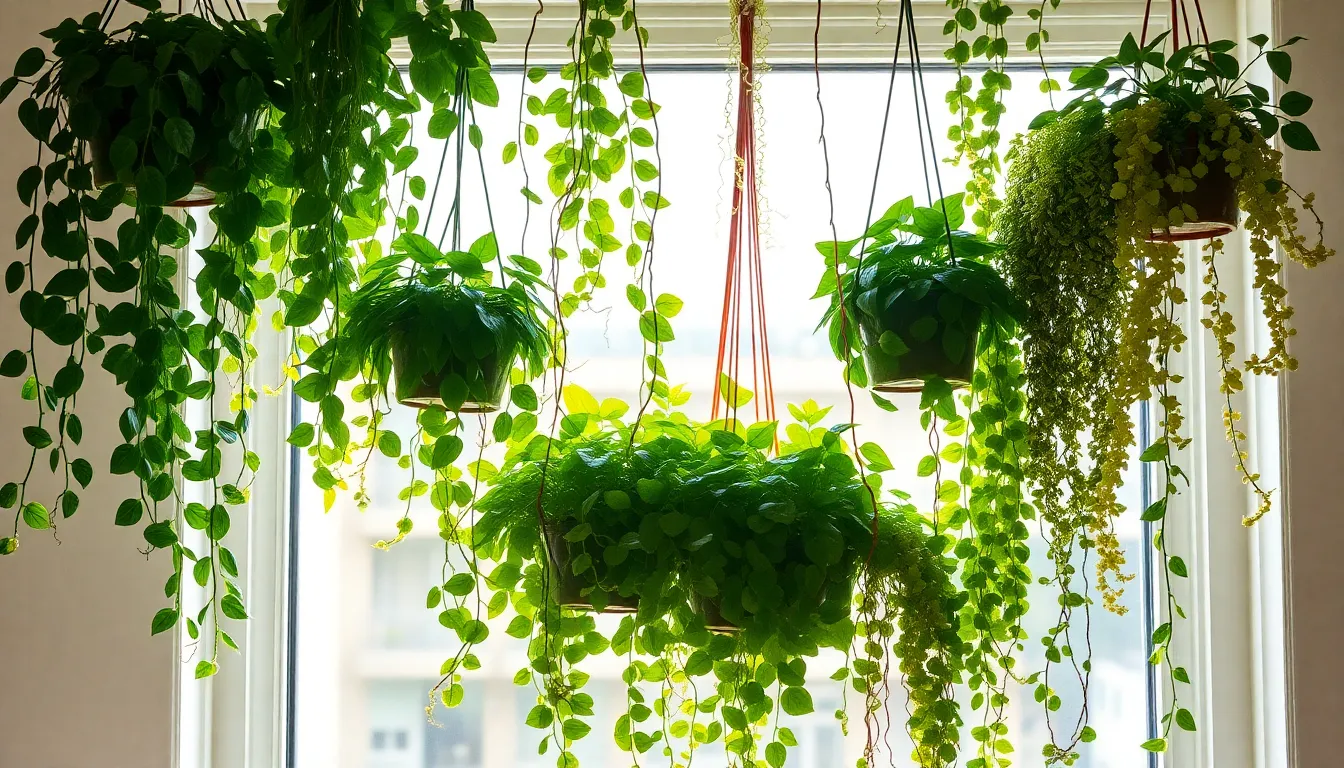
Transforming your window into a stunning green display requires thoughtful arrangement techniques that maximize both visual impact and plant health. We’ll explore proven strategies for creating balanced, textured displays that maintain year-round appeal.
Creating Visual Balance with Plant Heights
Varying plant heights creates ever-changing visual interest that prevents your window display from appearing flat or monotonous. We recommend placing taller plants at the center or to one side, then arranging shorter or trailing plants around them to establish natural flow.
Staggered hanging levels maximize light exposure while avoiding visual clutter in your window space. Using S-hooks on curtain rods allows you to easily reposition plants as they grow or as lighting conditions change throughout the day.
Trailing plants like pothos, ivy, or string of pearls work exceptionally well when hung from curtain rods, creating lush cascade effects that draw the eye downward. Positioning these cascading varieties at different heights adds depth and movement to your arrangement.
Mixing Different Plant Textures and Colors
Combining plants with contrasting leaf shapes, sizes, and colors enhances the overall texture and visual appeal of your window garden. Pairing succulents with broad-leaf tropical plants creates striking textural contrast, while mixing variegated foliage with solid green leaves adds sophisticated depth to your display.
Different textures prevent your arrangement from becoming visually monotonous and create focal points that capture attention. We suggest grouping plants with similar care requirements but diverse appearances for both aesthetic appeal and practical maintenance.
Seasonal bloomers can be rotated into your permanent display to provide fresh color pops throughout the year. This approach allows you to maintain your core arrangement while introducing temporary bursts of seasonal beauty.
Seasonal Rotation Ideas for Year-Round Appeal
Changing trailing and potted plants seasonally maintains visual interest while addressing your window’s shifting light conditions throughout the year. This rotation strategy ensures your display remains vibrant regardless of outdoor weather or daylight changes.
Spring and summer seasons call for flowering plants or vibrant foliage varieties that thrive in increased natural light. During cooler months, we recommend opting for hardy evergreens or low-light tolerant plants that can handle reduced daylight hours.
Incorporating plants that naturally thrive in your window’s exact light conditions requires adjusting placement or plant choice as natural light shifts seasonally. This strategic approach ensures each plant receives optimal growing conditions while maintaining your display’s visual appeal year-round.
Conclusion
We’ve covered everything you need to transform your windows into thriving plant displays that’ll breathe life into your home. From selecting the perfect plants for your lighting conditions to mastering installation and maintenance techniques you now have the tools to create stunning vertical gardens.
Remember that success with hanging window plants comes down to understanding your space choosing appropriate hardware and staying consistent with care routines. Whether you’re working with a tiny apartment window or a spacious bay window these techniques will help you maximize your growing potential.
Your windows are waiting to become beautiful focal points that purify your air boost your mood and showcase your green thumb. Start small experiment with different arrangements and watch as your hanging garden transforms your living space into a natural sanctuary.
Frequently Asked Questions
What are the best plants for hanging in windows?
The best plants depend on your window’s light conditions. For full sun windows, consider succulents and herbs. Partial sun windows work well with begonias and fuchsias. For low-light areas, pothos, ZZ plants, peace lilies, and philodendrons are excellent choices that thrive in shade and are perfect for beginners.
How do I choose the right hanging planter for my window?
Select planters with proper drainage holes to prevent root rot. Use removable containers for easier maintenance and waterproof saucers to catch excess water. Consider the weight capacity of your mounting system and choose lightweight materials like plastic or ceramic for window installations.
How far should hanging plants be from window glass?
Keep high-light plants 12-18 inches away from south and west-facing windows to prevent leaf burn from intense sunlight. Plants that prefer bright indirect light can be placed closer to the glass. This distance helps regulate temperature and prevents heat stress on your plants.
What’s the best way to water hanging plants in windows?
Check soil moisture regularly and water when the top inch feels dry. Adjust frequency based on seasons – more in summer, less in winter. Use controlled watering techniques to prevent water damage to window areas, and consider self-watering systems for consistent moisture delivery.
How do I install hanging hardware safely for window plants?
Use appropriate hardware based on plant weight. For ceiling mounting, use screw-in hooks with toggle bolts and locate ceiling joists with a stud finder. For window frames, try tension rods for temporary displays or adjustable mounting brackets. Wall-mounted brackets work well for side windows.
How can I prevent pest problems in my hanging window plants?
Conduct regular inspections of leaves and stems for early pest detection. Isolate any affected plants immediately to prevent spread. Maintain proper air circulation around plants and avoid overwatering. Keep plants healthy through proper care, as stressed plants are more susceptible to pests.
What should I do if my hanging plants get too much heat from the window?
Move plants 12-18 inches away from glass, especially on south and west-facing windows. Choose heat-tolerant plant varieties for sunny locations. Provide additional humidity through regular misting or humidifiers, and ensure proper air circulation to help plants cope with higher temperatures.
How do I create an attractive arrangement with multiple hanging plants?
Vary plant heights and mix different textures and colors for visual interest. Space plants adequately to prevent shadowing and promote healthy growth. Consider seasonal rotation to maintain year-round appeal and adapt to changing light conditions throughout the seasons.

